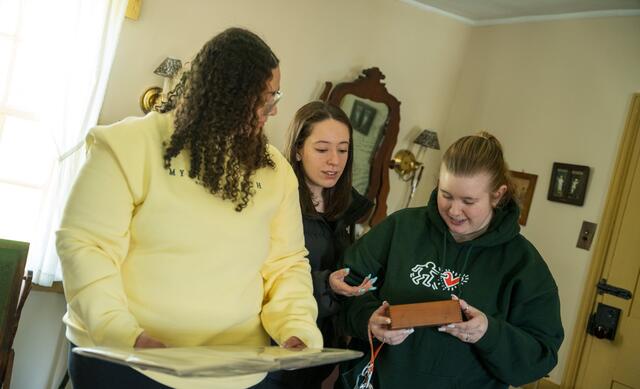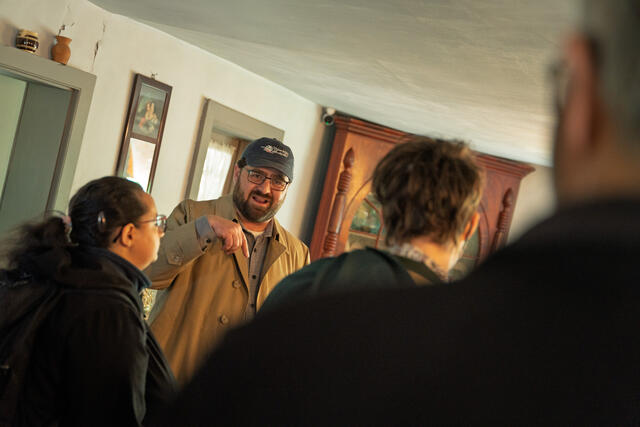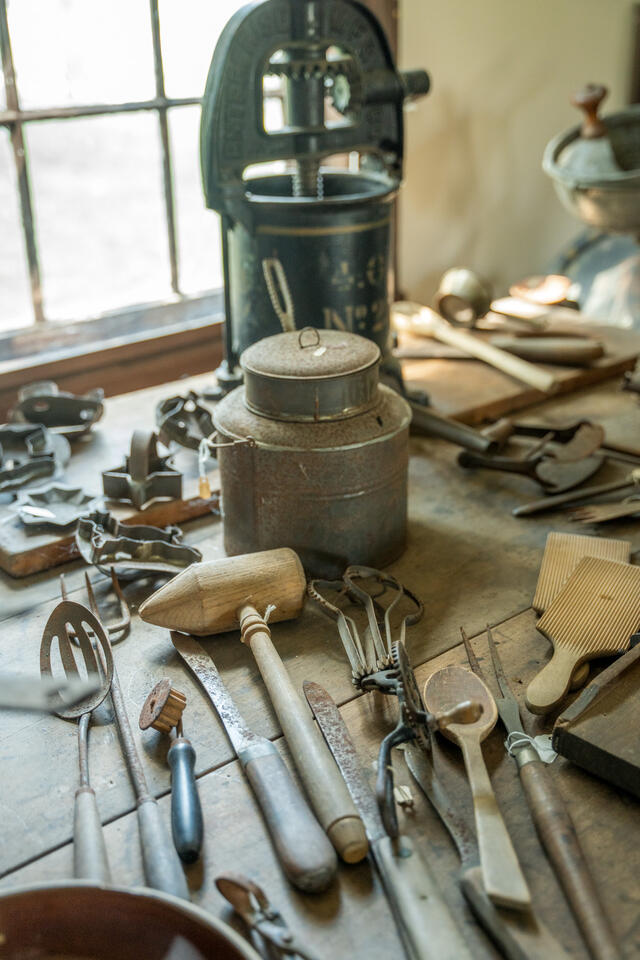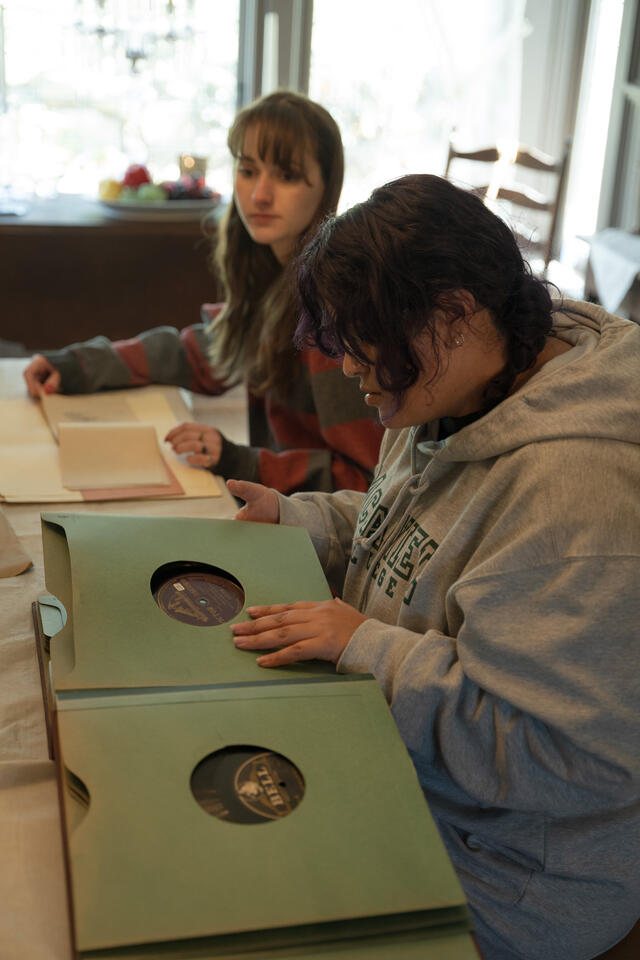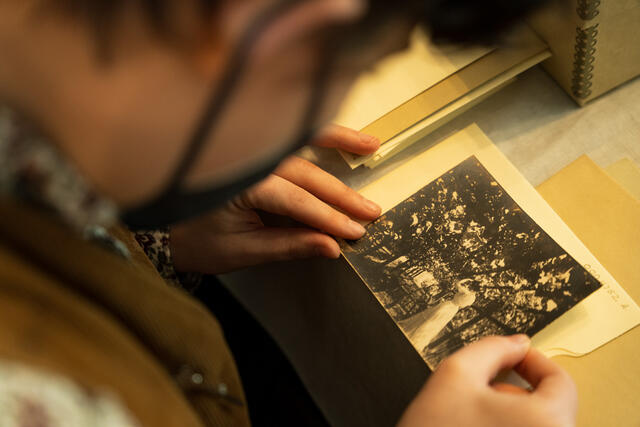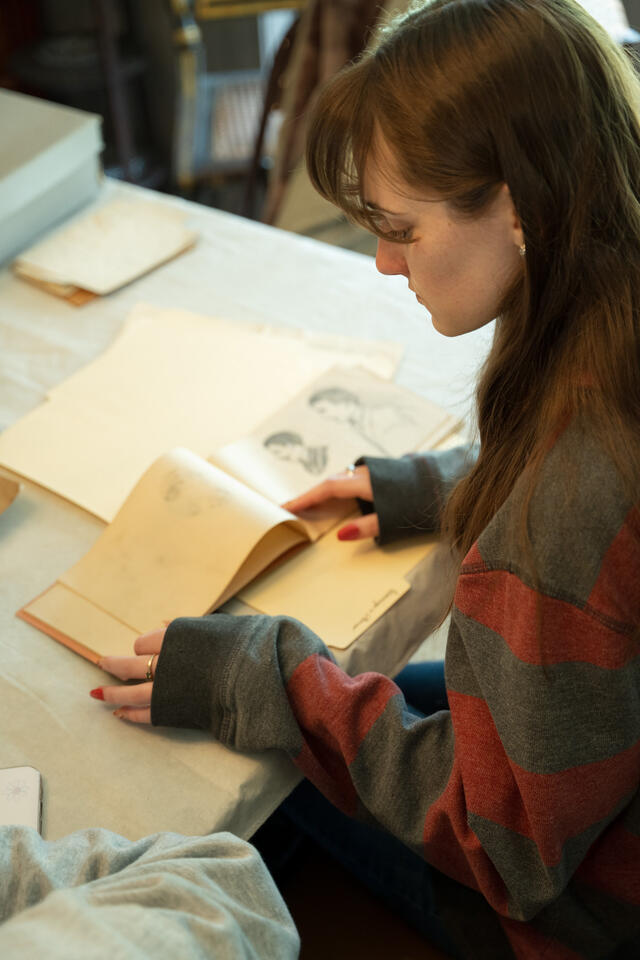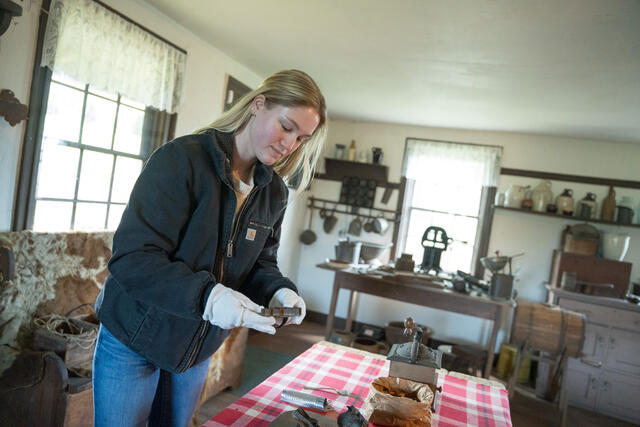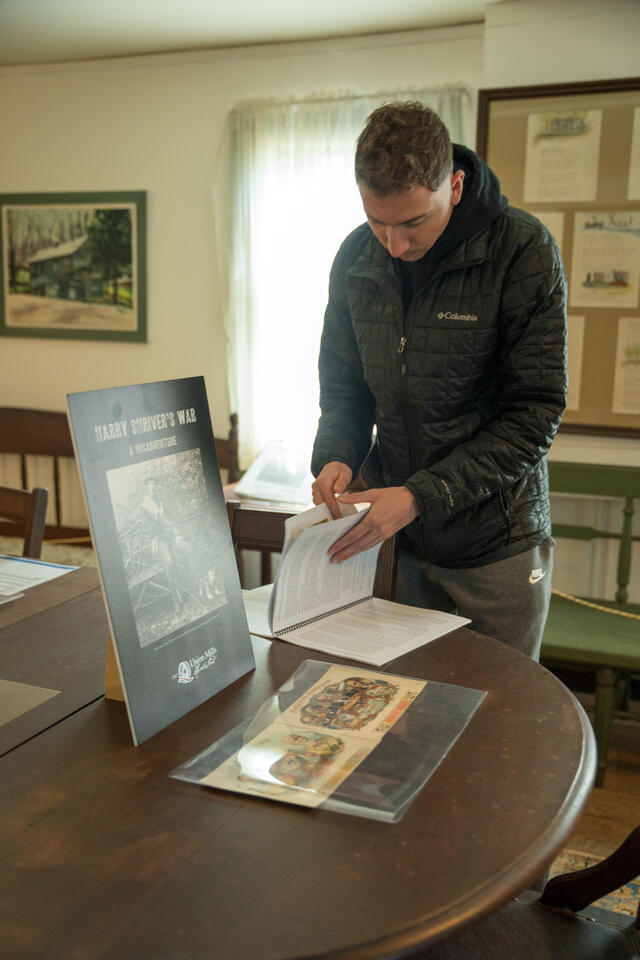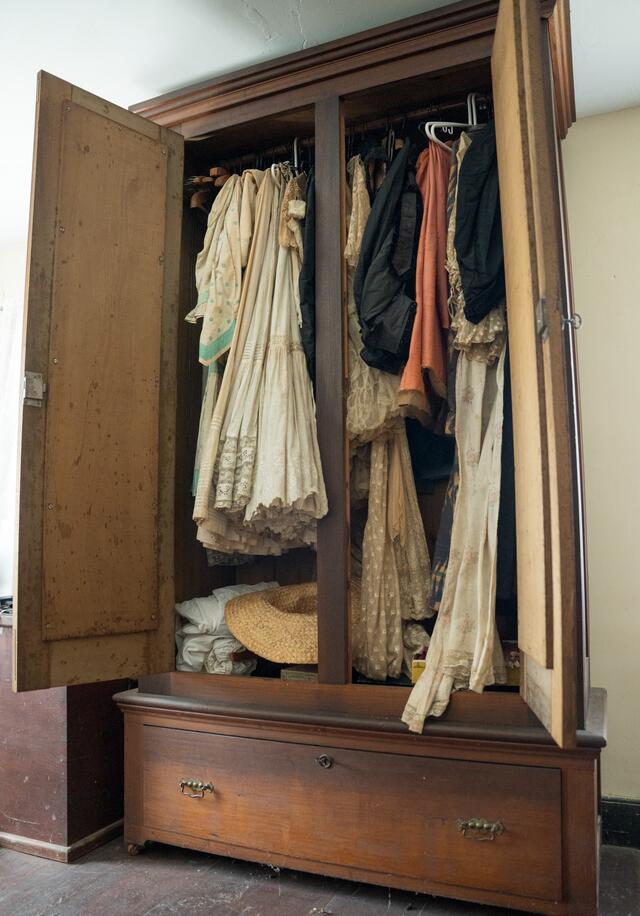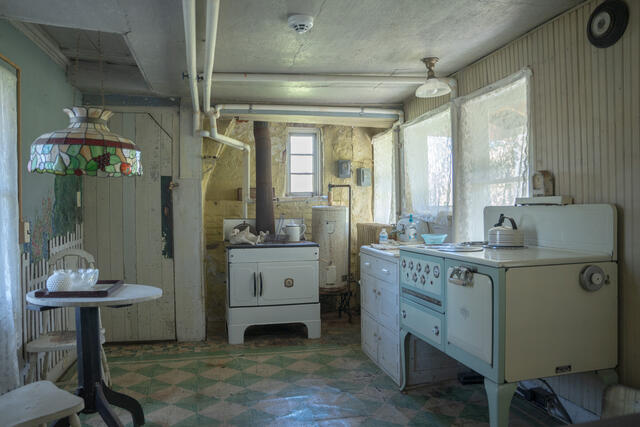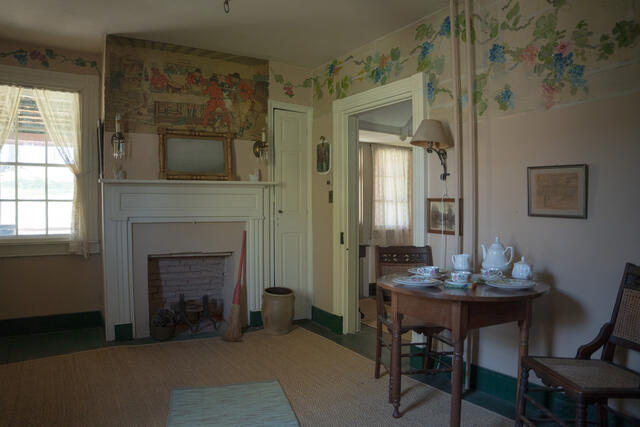Students investigate history firsthand at Union Mills Homestead
In an experiential course called Hands-On History, McDaniel students conducted research at Union Mills Homestead in Westminster, Maryland, for the spring 2025 semester. The historical site and its archives offer a unique chance to study artifacts in person and learn about public history.
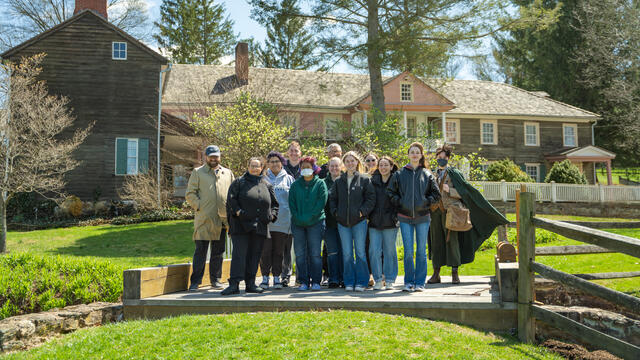
Director of Union Mills Kyle Dalton with McDaniel students Anjani Martins, Sherlyn Estrada, Nicholas Henderson, Eli Romero-Cruz, Emily Liszewski, Professor Bryn Upton (back), Alicia Heard, Alicia Toomey, Lindsay Clearwater, Savannah Marzullo, and Robin Odom (l-r),
In the rustic, 18th-century kitchen of the historic Union Mills Homestead, McDaniel sophomore Alicia Heard dons a pair of white gloves and carefully examines the cooking utensils that enslaved African American women used to feed the household in the early 1800s.
As part of her research project for Hands-On History, Heard is analyzing recipes found in the home. Many were clipped from newspapers printed after slavery was abolished, and Heard is investigating their similarities to recipes that were typically cooked by enslaved African Americans, like one longtime cook in the homestead named Ruth.
The class goes beyond just reading about history in textbooks. Instead, Heard is immersed in the room where decades of cooking took place in the homestead. She’s taking a close look at the items to develop a deeper understanding of the setting, which tells a thousand stories.
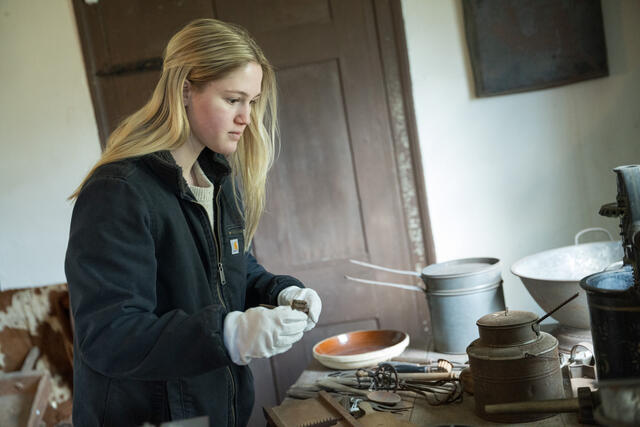
Alicia Heard donned white gloves to handle artifacts in the 18th-century kitchen of Union Mills Homestead.
“We’re getting super hands-on,” Heard says. “Since I’m not a History major, I’ve never touched artifacts like this, so it’s really nice to be able to wear the gloves and interact with them.” As an Elementary Education major, the research experience enriches her knowledge in a subject area she may one day teach.
Her immersion is exactly what History Professor Bryn Upton wants students to do on their trips to Union Mills.
While designing the experiential course, Upton connected with Kyle Dalton, director of Union Mills Homestead, and arranged for students to conduct research at the local Westminster landmark. The partnership benefits both students and the historical site through uncovering more about its history.
“The enthusiasm of the students for so many different topics has been great,” Dalton says. “Some of their projects are as broad as the history of slavery on the site, spanning generations. Others are hyper-focused on the dresses in our collections. People have gravitated toward cookbooks or architecture or political history.
“It’s such an interesting atmosphere of everyone coming up with their own ideas and bringing their own experience to the table to help us look at this history from different perspectives,” he adds.
Union Mills, built in the 1790s, is a former grist mill and sawmill and the ancestral home of the Shriver family. The Shrivers were prominent in Maryland, and their descendants are known for things like establishing the Special Olympics. Among other notable parts of the homestead’s history, it was used at one time as a post office — the first to offer Rural Free Delivery in the United States.
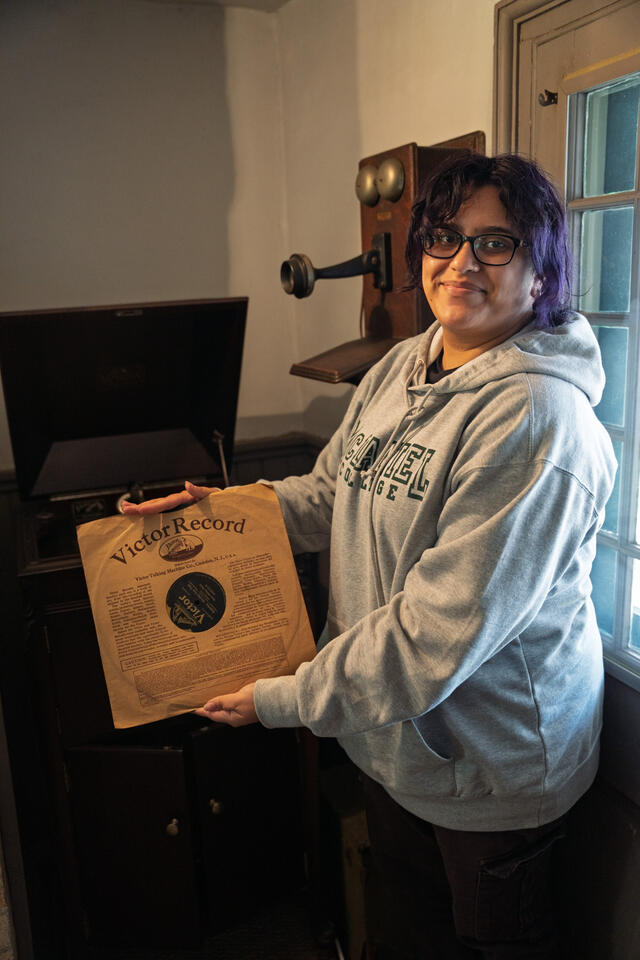
Sherlyn Estrada took a closer look at the Victrola and Victor Records collection in the home.
With 160 years of history to explore on site, Upton encourages his students to approach the research in a way that fits their interests. They can write a classic research paper using primary documents or trace the history of specific objects in the house.
“I want them to see what’s there and what speaks to them, what connects to an interest they might have,” Upton says. “Students can also ask what the homestead might need — is there a project they’ve always wanted to do but just haven’t had the time or resources, so a McDaniel student could help with it?”
On their visits to Union Mills, students in the class can explore the archives and 23 rooms to develop their research projects. They’re able to go beyond the typical tour route and see spaces not often on display.
Beyond the kitchen, there’s a children’s room filled with historical toys and books; sitting rooms with artwork and furniture; and an upstairs bedroom with a closet of clothing from throughout the decades.
Each item seems to wait, quietly, for a student-researcher to approach and begin asking questions.
Discovering Big Stories in Small Objects
Just inside the front door of the home sits a Victrola, the first record player invented to play music at home. Beneath it are binders filled with records, and one senior History major wondered why a family of German origin had so many Hawaiian and Irish music records.
A few simple questions about the collection turned into a study of tourism, immigration, and popular culture for Sherlyn Estrada.
“It was in the 1890s when the United States annexed Hawaii,” Estrada says. “Afterwards, tourism got really popular, as did their cultural music. As for the Irish music, that had a lot to do with immigration. There was one specific musician that I kept seeing named John McCormack, and I found out that he was very famous in the early 1900s to the 1920s.”
Her project also extended into the origins of the Victor Talking Machine Company that produced the Victrola and Victor Records, beginning in the early 1900s.
Upstairs, the children’s bedroom is filled with artifacts from bygone childhoods.
Senior History major Alicia Toomey was drawn to the colorful books. “I’m looking at how children’s literature has changed from the time children were in the house to now, and what these books show about their cultural beliefs and values and how parents instilled them,” Toomey says.
“I like how personal it is to do research here. This was somebody’s home for generations, and it’s not like a museum where you would just get bits and pieces. It's the whole picture of how things fit into life back then,” Toomey says.
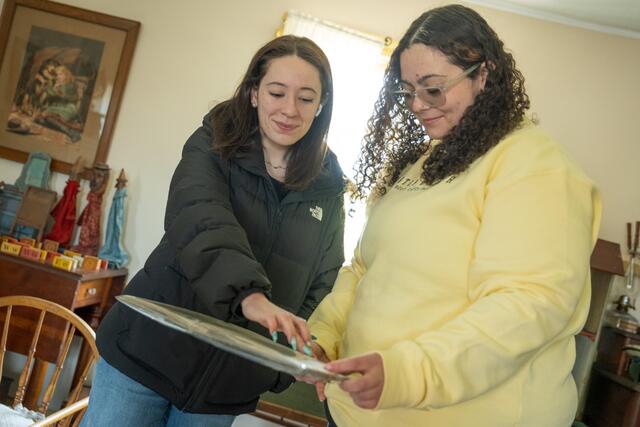
Lindsay Clearwater and Alicia Toomey examine a children's book together at Union Mills Homestead.
Fellow researcher and senior History major Emily Liszewski was fascinated by the toys, which include dolls and wooden models. “I’m particularly interested in how large-scale manufacturing has changed them,” Liszewski says.
“Toys used to be homemade and customized, and a lot of the dolls here are personalized, framed after people that they knew, because they were given to them by people that they knew,” she says. “Today, toys usually aren’t connected to you in any way.”
Beyond the children’s room, senior History major Lindsay Clearwater was intrigued when she came across a mention of a murder trial in a series of letters.
“One of the letters referenced that someone in the family had sat on a jury for a murder trial. So, I researched the trial, which was for an enslaved woman, and looked at court transcripts. I also identified similar trials to look into their verdicts,” she says.
“The hands-on research experience is the best part,” Clearwater adds. “Once, I came in on my own time and talked with the director and archivist, and they let me go through all the different letters and materials,” Clearwater says.
Experiential learning is a key component of the McDaniel Commitment, which encourages and supports students in pursuing research, internships, leadership roles, and more, both on and off the Hill. In classes like Hands-On History, students can earn their experience credit in an academic setting.
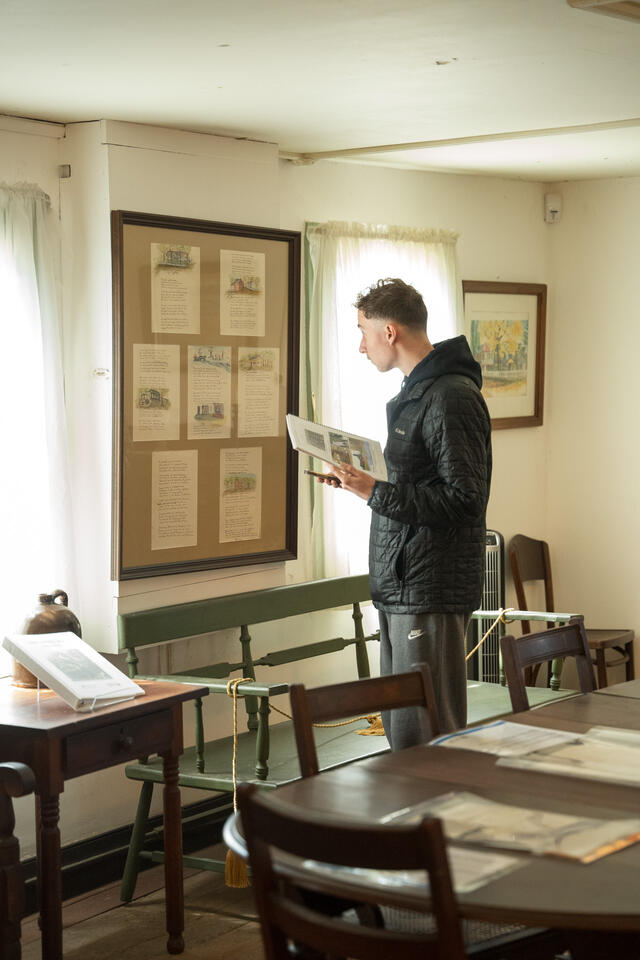
Nick Henderson's research narrowed in on land surveys for Union Mills.
“With this class, I want to have our students — especially seniors who’ve been through a capstone experience and done primary research — apply their skills in this specific way, in this place, and in this time that was so different from today,” Upton says.
Building Research Skills with Passion Projects
It wasn’t every student’s first time at Union Mills Homestead, but for the ones familiar with the site, visiting as a researcher made it feel entirely new.
“I come out here every year, and my parents actually got married here,” says History junior Nick Henderson. “When I saw this class offered, it was a chance to learn more about it. I also like to focus on early American history, which Union Mills is perfect for studying.”
Henderson is looking at land surveys to analyze the size of the property over time. He's also looking at the building blueprints to see Union Mills’ influence on the Westminster area community, due to it once being a rural hub that provided many locals with jobs and social connections.
For some students, the class is a chance to tie their passions into their liberal arts studies.
Senior English major Robin Odom is an aficionado of historical clothing and textile preservation, which made the home’s armoire filled with pre-1920 clothes a happy surprise. With little to identify the clothes besides their style, Odom is matching the clothing to photographs in the archives to pinpoint when they were most likely made and worn.
“I am very interested in historical clothing, so I focused my project on why clothing is so important to our understanding of the past,” Odom says.
The course is what students make of it by bringing in their interests and passions, and it’s Upton’s hope that student researchers in the future will bring new insights and perspectives to their research.
“This is an opportunity to take their skill set and apply it to something new to see what they come up with,” Upton says. “And if I teach this course five years from now, we’ll see how technological advances or social change affect how students look at the same collection.”
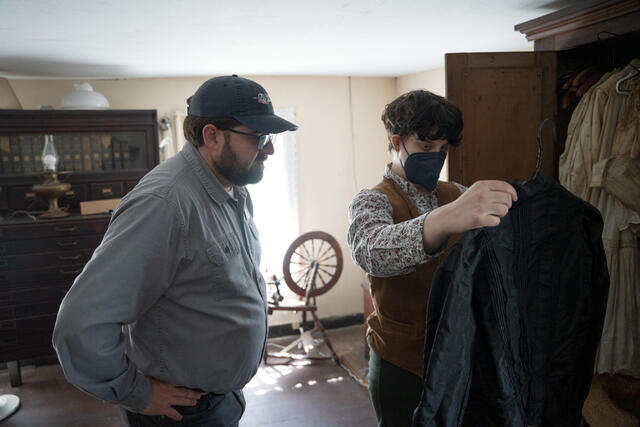
Kyle Dalton, director of Union Mills, stands with Robin Odom as they take a closer look at historical clothing in the home.
Preparation for the Growing Field of Public History
Hands-On History introduces students to the concept of public history — how the general public interacts with and learns about history. In contrast to academic history, public history is typically shared through museums, national parks, historical landmarks, as well as books, TV shows, and documentaries.
“There are more museums than Starbucks and McDonald’s locations in the United States,” Union Mills Director Kyle Dalton says. Yet only “30% of Americans are regular attendees at museums,” so it can be difficult to attract that small group of history lovers.
“People increasingly want personal stories and even sensorial experiences to learn what it sounded, smelled, and felt like to live during a certain time of history,” Dalton says. For Union Mills, the enthusiastic efforts of the students have been exciting to see, and their interest in certain items or topics could spur future projects for the site to share with the public.
The class also prepares students for the constantly evolving field of public history, giving them familiarity with managing research and communicating findings.
Upton says he’s “more likely to have a student who might someday decide to pursue history, get a master’s degree, and go work at the History Channel than someone who might write a book. And to be fair, more people will watch a documentary than will read it.”
Beginning in the fall of 2025, McDaniel College will offer a new minor in Public History, designed to be easily paired with any major. After all, every industry has a history, so keeping track of it and communicating about it is a valuable skill.
“More and more of our students are going into public history. Gallery spaces, museums, archival spaces, libraries, national monuments, national parks,” Upton says. “Many of our History graduates will start out working in a historic home or something similar before going to graduate school. So, we have to shift our preparation for students to support their career goals.”
